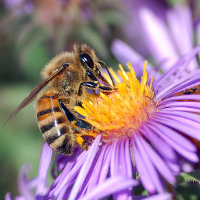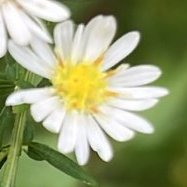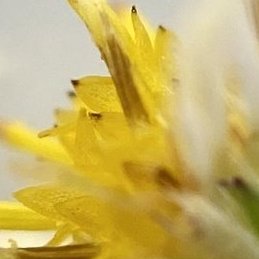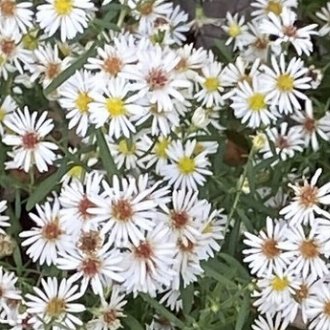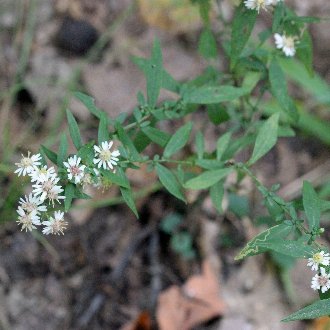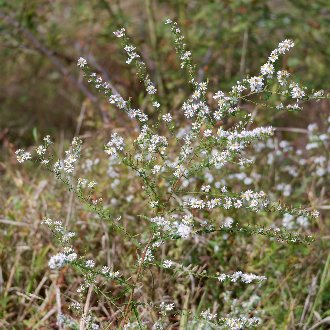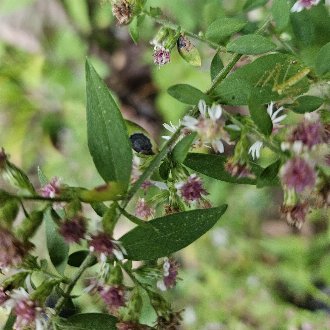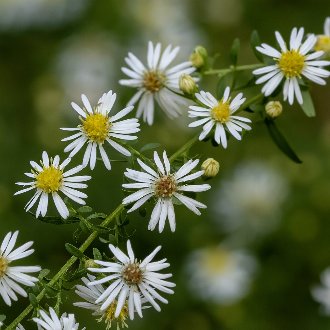Calico Aster vs Small White Aster
This guide is under construction and has not been published yet. It may have errors. When in doubt, double-check other sources for definitive ID.These two species are easily confused; both have small flowerheads, similar basal leaves, bloom at the same time, and can grow together in the same habitat, preferring moist sites with a history of disturbance. S. lateriflorum ranges farther west and much farther north, and has fewer gaps in its range. It tolerates greater shade, prefers slightly better drainage, and ranges into drier conditions. S. racemosum has a more restricted, patchy range, although it can be locally more common in certain regions. It requires more sunlight, is slightly more tolerant of waterlogged soil, and is more restricted to moist conditions.
Calico Aster (Symphyotrichum lateriflorum) | Small White Aster (Symphyotrichum racemosum) |
A perennial of moist, partly-wooded areas in eastern to central North America. | A perennial, mostly of sunny bottomlands, native to Eastern North America. |
Flowerheads typically have 8-15 rays, rarely as many as 23. Rays are shorter, usually 3-5mm, rarely as short as 2.5mm, and are consistently wider, 0.9-1.2 mm wide. Photo © skylar_schell, Public Domain. | Flowerheads typically have 16–21* rays, rarely as few as 12 or more than 21. Rays are longer, 5-8mm, but average narrower, 0.5-1.2 mm wide. Photo © Ruth B, Public Domain. |
Lobes of disc floret corollas (flowers in the center of each flowerhead) are more strongly reflexed. Photo © Christopher Volker, CC BY 4.0. | Lobes of disc floret corollas are either only slightly curved back, or sometimes not at all. Photo © David LaMagna, CC BY 4.0. |
Pollinated disc flowers turn a more purplish hue; pollinated discs look distinctly pink to purplish from a distance. Photo © Wes Gapp, CC BY 4.0. | Pollinated disc flowers turn a less purplish hue, more pink to red, but pollinated discs tend to look more brownish from a distance. Photo © Sandy Wolkenberg, CC BY 4.0. |
Tolerates greater shade and tends to occur in shadier habitats, although may also occur in sunny habitats. Photo © Trix Niernberger, Public Domain. | Requires more sunlight and is more restricted to sunny habitats, although it may be found in habitats with some overhead shade. Photo © Bonnie Semmling, CC BY 4.0. |
Leaves and bracts (leaflike structures) in the inflorescence are much broader and larger overall, not as much reduced from the lower leaves. Inflorescence often looks more leafy than it has flowers. Photo © Daniel McClosky, CC BY 4.0. | Leaves and bracts in the inflorescence are much narrower and smaller, greatly reduced from the lower leaves. Inflorescence looks like it is all flowers with barely-noticeable leaves. Photo © Dan Vickers, CC BY 4.0. |
Additional Notes
FNA says that A. G. Jones (1989) reported hybridization between these two species. However, we found no contemporary sources reporting hybrids in the wild. It is likely that if they do hybridize, natural hybridsBoth FNA and FSUS say that S. racemosum only has up to 20 ray florets, but we have seen numerous records of flowers of that species with 21 ray florets, and uncommonly, slightly more than 21, so we think that count could be tweaked somewhat. It is not important for telling apart these two species, but it can be relevant when comparing S. racemosum to other species with a higher ray count.
References & External Resources
These short lists show only links helpful for ID. For a complete list of references and resources also covering other aspects of ecology, visit the links section of the full article on each plant, which is the first entry here.

